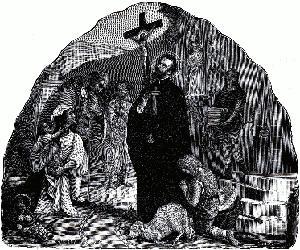Saint Camillus de Lellis
Feast day July 18

If not for St. Camillus de Lellis and his passion for helping the sick and dying, the red cross may not have become associated with such compassionate service to those in need. However, before he began caring for others, Camillus’s life was anything but saintly. He was born in Italy in 1550 to a mother who was almost 60 years old and his father, a soldier who loved to fight, was a persistent drinker and gambler who was rarely at home. Unfortunately for Camillus’s mother, her son was not easy to manage on her own. He was lazy, despised school which he frequently skipped, and had a fierce temper.

His mother died when he was only thirteen and a few years later, Camillus left school and teamed up as a nomadic soldier with his father whose appetite for gambling quickly rubbed off on his son. Together, they were ejected from one army camp after another for excessive gambling and fighting. Eventually, Camillus’s father fell deathly ill and, overcome with shame for his lifestyle, he received the Sacrament of Last Rites just before he died.
Shaken by the whole ordeal, Camillus decided that in order to mend his own ways he would become a Franciscan. The Order he approached, however, would not accept him because of an open wound on his leg that refused to heal. Camillus returned to his waywardness and eventually found himself in Rome where he began to work as a servant at San Giacomo (St. James) hospital in exchange for medical treatment for his leg. This arrangement worked well until he began teaching the other servants how to gamble which led to fighting. As a result, the hospital put Camillus back on the streets. He then joined the Venetian army but after being dismissed on account of his temper, he found himself gambling and losing everything he had, right down to his boots.
At 24 years old, he came upon a monastery being built and enrolled as a laborer. For a second time, he gained admittance to a Franciscan monastery but was once again rejected due to his leg wound. Camillus returned to San Giacomo hospital in Rome where he was given a second chance.
After four years, Camillus’s leg appeared to be healed and he returned to the Franciscan monastery where he was again received. It wasn’t long, however, before his wound re-opened and the Franciscans discharged him, this time urging him to give up hope. He returned to San Giacomo where he was welcomed back and employed as superintendent.
He realized in this role that it was only when administering to patients out of love that nurses provided adequate treatment and he made it his goal to raise the standard of care. In deciding that the field should include not only laymen but also priests, he realized he was being called to the priesthood. He was ordained in 1584 and recruited a group of both priests and laymen, who went about caring for the sick and dying on the streets. They distinguished themselves by wearing red crosses on their clothing.
Camillus’ organization spread throughout Italy and by the time of his death in 1614, he had founded more than 30 hospitals. He was canonized in 1746 by Pope Benedict XIV.
See the referenced source on the Order of St. Camillus.Image credit: Saine Camille de Lellis by Oscar Dehaes, 1914. Public Domain via Wikimedia.
Suggestions
-
Direct the students to find two newspaper articles: one an example of seeking passing happiness, the other an example of seeking lasting happiness. Have them contrast the two situations.
-
Invite the students to list the crutches that some teens rely on to escape problems. Discuss what these teens are missing in life and how they can be helped.
Suggestions are excerpted from Christ Our Life, by Sisters of Notre Dame of Chardon, Ohio

